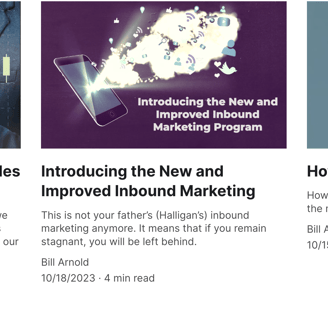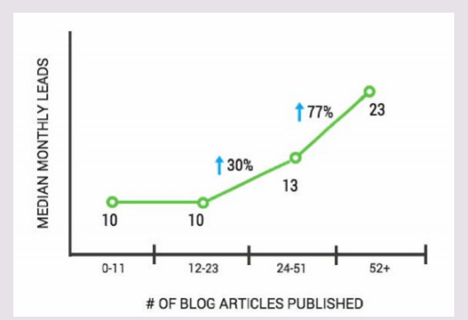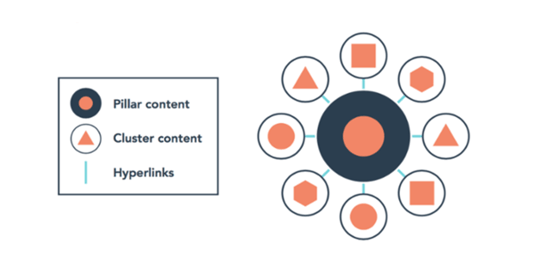Blogging Your Way To Growth!
Blogs can provide a wealth of information on topics of interest to your targeted audience. This will be rewarded by the search engines and allow the reader to trust the information they find on the blog. This trust will translate into new clients.
GROWTHBLOGMARKETING/SALES SUCCESSSUCCESSSALES
Bill Arnold
11/7/20239 min read


We are often asked how important is blogging to having a successful marketing program. Hasn’t become sort of passe’ with all the other cool ways to get your message out to your targeted audience.
Actually, it has never been more important. The way we buy products and services has changed. We no longer seek out a salesperson to explain by their product is the best or how it can solve my problem. We figure that out first and then contact the company. We have learned to use the internet to avoid having a salesperson tell us their biased view on why we should buy their product or service.
In order for us to figure out what is the best solution, we go to the internet to learn. If somebody is educating your prospects, that is not you who is doing so, then you most likely will not get the sale.
How does blogging help your grow your business? Let’s drill down.
The Benefits of Blogging
Improved SEO - Search engines love fresh content that addresses a question, pain point, interest, or concern (QPIC) that website visitors inquire about when making the search.
Search engine bots have two main functions — crawling content and building an index.
This allows Google to know which sites can provide answers to such questions as “What is the best solution for your problem or concern?” Your website will not be found if you do not have an aggressive addition and sharing of content.
Each time you create a new blog post you get one more page for the search engines to index on your website. This is simply another opportunity for your site to show up on the results page of any search inquiry. This will translate to more organic targeted traffic.
Improved Credibility and Trust - Ninety-nine percent (99%) of people won’t buy on their first visit to your site. They come simply to try to understand who you are, why should they care, and most importantly can solve a problem they have. The website visitor is looking to learn, not be sold. You need to have content that really is about solutions to their problem. If they find your content informative and credible, they will come back when they are ready to buy. This may take a number of visits (usually seven), but if they come back and each time, they see new and relevant information, they will begin to trust you have the solution to their problem.
A well-formulated blog that is optimized with relevant keywords, that does not simply say buy here but helps them get answers to the searches made will drive more traffic and resonate with the traffic that comes. When you provide valuable and relevant content that gets indexed well, your products and services start becoming the top options shown to an internet user during his search. By addressing QPIC of your website visitors, each new piece of blog content increases your credibility and their trust.
Lead Generation - New content also provides you the ability to use a normal fashion highly sought-after keywords and long-tail keywords. This increases the opportunity for you to increase the visibility of your site on the Search Engine Result Pages (SERPS). The new content on your blog also gives additional credibility to your website, and it creates opportunities for you to include the most important keywords in your posts that are sure to help you increase the visibility of your site on SERPs.
Improves Social Proof - We stated earlier that the distribution of the content is equally important as its creation and quality. Your blog content should be the foundation of your social media marketing efforts. Every time a blog is created, it needs to be shared across all social media platforms. This will not only drive traffic back to your website but also improve your organic traffic as Google looks to social proof as one element in its algorithms.
Company Voice - Blogging gives your company a voice. It provides your business with a platform for sharing ideas, talking about new products and services, and commenting on new industry trends. Blogging also helps your customers get a better sense of your company’s vision and corporate standards. In other words, blogging lets you tell the story of your brand.
Client Retention & Loyalty - By providing your readers with an insight into your company, you are making an emotional connection with them that will easily translate into customer loyalty over time.
Not Convinced? Let’s Examine the Numbers
A blog is critical for a website for the optimization of the user’s trust and for the search engines to send organic traffic to your site. Here are some statistics that demonstrate the value of having a blog:
❖ A website with an active Blog generates 126% more leads
❖ Interesting content is one of the top reasons people follow brands on social media
❖ 81% of US consumers trust blog advice and information
❖ Companies that blog have 97% more inbound links
❖ Websites with blogs have 434% more indexed pages
❖ Companies that published 16+ blog posts per month got almost 3.5X more traffic than companies that published 0-4 monthly posts. (HubSpot, 2015)
❖ Companies that published 16+ blog posts per month got about 4.5X more leads than companies that published 0-4 monthly posts. (HubSpot, 2015)
❖ You have a 434% higher chance of being ranked highly on search engines if you feature a blog as part of your website (Tech Client).
❖ Businesses using blogs as part of their content marketing mix get 67% more leads than those who don’t (HubSpot).
What are Best Practices?
If something is worth doing, it is worth doing right. It is simply not enough to write blogs; they need to be properly formatted and shared both on your website and across the internet. Here are some of the more important considerations to ensuring that your blogging efforts help deliver growth.
Home Page Blog Summary - The content found on most website's home pages is usually static information. This does not give Google any reason to send people to your site. Having a blog summary on your home page will provide that fresh new content they are looking to share. If these sections are not robust and constantly sharing new and relevant content your SEO will suffer and you will not see organic traffic. Below is an example of how one company shares its blog content on its home page:


Format - To maximize the effectiveness of any blogging program it is important that the reader can relate the person writing the blog. Human to Human marketing works the same way for B2B and it does for B2C engagements. People like reading blogs written by other people not some corporate entity. Impersonal blogs do not garner the same level of trust. Identify several people in your organization and have blogs written for them and share the same type of information that is provided for guest bloggers.


Medium - Not everyone likes to read blogs. While they are imperative for marketing/sales success, the written blog only represents one medium, the written word. Many people will not take the time to read and digest the information that would improve their understanding of your product and how you can help solve their problems. That is why your blogs need to have a mix of traditional written blogs, infographics, podcasts, and videos.
When you use alternative medium, remember that they are not indexed the same way as the written word. If you have a video, have it transcribed below it. If you post an infographic have text explaining the content.
Blogging Recommendations
Adopt an aggressive blogging program.
The first step is creating content that will drive highly qualified traffic to your website. Our top recommendation is to begin blogging for your business. While it can be intimidating to produce relevant and valuable content on a regular basis, especially with limited resources, it’s attainable. In addition to the written blog, it is best to incorporate blogs that are comprised of videos, slides, webinars, events, and infographics. In fact, HubSpot found that businesses with blogs that have accumulated at least 51 posts see 53 percent more traffic than blogs with 20 to 50 posts.


Every blog should be a minimum a short form blog that has between 600 – 1500 words. Ideally at least 50% should be a long form blog which are between 1500 – 2000 words in length
Blogs can provide a wealth of information on topics of interest to your targeted audience. This will be rewarded by the search engines and allow the reader to trust the information they find on the blog. This trust will translate into new clients.
The obvious answer is how much organic traffic do you want. The chart above shows the reality of generating more blogs if they are all high quality. It is possible to generate tens of thousands leads every month simply by a robust blogging program.
In the ideal world, there would be a MINIMUM of 30 quality blogs per month. However, it is critical to place quality over quantity and if there are not sufficient resources to generate more blogs than there is a sweet spot that a company must adhere.
The studies have shown that:
❖ Companies that blog 11+ times per month got more than 4X
❖ Companies that blog 16+ times per month got 4.4x more leads
The best utilization of resources would be to have 11+ blogs per month for each business category. Each blog needs to have a CTA to share a resource or offer a product. This CTA should be to a graphic representation of a resource of gated content.
Short Story – A few years back at a HubSpot partners’ meeting, I listened to an agency owner describe how eight months earlier they were on the verge of closing, they could not generate enough top of the funnel leads to nurture into clients. They left all go but a handful of team members. Since they had no clients, they had nothing else to do but write and video blogs. They were putting out 150 blogs a month! Excessive? Absolutely but the results were amazing. In less than two years they became one of the biggest and most profitable agency in the HubSpot ecosystem. They did this simply by harnessing the power of blogging.
How Much is Enough?
What is the Right Mix of Blogs?
Blogs need to provide a diverse mixture of both topics and formats to appeal to individual reader’s taste. The following should be used as a guide until data is obtained to suggest a different mix would be better.
While long-form content is typically defined as over 1,500 words, a Backlink study showed that the average first page results on Google contains 1,890 words.
Long form content with an index can not only increase engagement by having a way for the reader to interact with the content, but also increase the amount of content consumed by keeping readers on the page. This is great news since only two-thirds of readers will engage with content for longer than15 seconds, per ChartBeat.
The recommended approach is to have 50% of your blogs be over 1,500 words and the balance to contain at least 600 words.




What is the Right Blog Length?
Utilized Pillar Blog Post Strategy
A pillar blog page is a blog post that covers all aspects of the topic on a single page but will then be enhanced with cluster blogs that provide for more in-depth reporting. The in more detailed cluster blog posts will have hyperlink back to the pillar page.
Pillar pages are longer than typical blog posts -- because they cover all aspects of the topic you're trying to rank for -- but they aren't as in-depth. That's what cluster content is for. You want to create a pillar page that answers questions about a particular topic, but leaves room for more detail in subsequent, related cluster content.


The reason for implementing a pillar blog post strategy is because Google rewards websites that have layers of content. The cluster blogs will give you the opportunity to provide more depth of knowledge and will also provide great source material for internal equity passing links.
Conclusion
In keeping with our own recommendations, we want to invite you back to the next cluster blog in this series where we will be sharing tricks, tips, and strategies to make your blogging program a lead generating growth engine. If you are ready to get professional help and support that will partner in your success, contact us today!
Contact:
prevailer@prevail.marketing
(424) 484-9955
